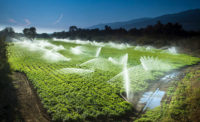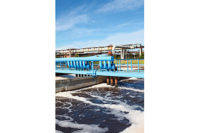Tech Processing
Cleaning wastewater, naturally
Poultry and beef processors experiment with new technologies to clean wastewater and reduce their water footprints.




Is there a more natural way to clean wastewater? Poultry and beef processors are certainly trying, by experimenting with new technologies created by Mother Earth to treat wastewater and reduce their water footprints.
Sometimes, less is more. “When we use less water, we use less energy,” says Stephanie Shoemaker, manager of environmental services at Sanderson Farms, based in Laurel, Miss. “Using less water means our wastewater systems treat less water; treating less water means using less electricity to move water, using less electricity to provide aeration and lower chemical costs for treatment.”
In a time of tightening water supply, slaughterhouse facilities create wastewater that is, well, really wasteful. It’s chock full of biological matter that is generally hard to clean and re-use: a high biological oxygen demand (BOD), total suspended solids (TSS), and fats and oils and greases (FOG) content.
Furthermore, this wastewater can contain chemicals from the hide processing and wash water that need aeration and mixing to break them down. If not treated properly, the BOD and TSS levels can create sludge and odors and the plant will fall out of compliance with acceptable permit levels from the local or federal government.
Food and animal waste is usually first treated with dissolved air flotation because it removes about 80 percent of the organic load and 65 percent of the nitrogen load. The remaining sludge is then treated with anaerobic digestion, which uses microorganisms to break down biodegradable material and produce biogas for electrical and thermal energy.
The last stage of treatment involves sorting and treating the leftover sludge (the digestate) into fertilizer that meets local and federal environmental standards.
Starting from scratch
After building five new wastewater facilities in the past 12 years, poultry processor Sanderson Farms is comfortable utilizing the latest equipment and technologies.
“We operate our facilities to maximize denitrification and use computers to control our aeration/anoxic cycles which minimizes electricity costs,” says Shoemaker. “At the processing plant, we also use the newest technologies to process birds — again, minimizing water, gas and electricity costs.”
Sanderson’s older facilities are retrofitted with newer technologies so all of its operations are consistent and can operate with minimal impact on the environment, she says.
In fact, at seven of the 10 Sanderson Farms facilities outfitted with full wastewater treatment systems, the water is treated and returned to the environment via direct discharge, says Shoemaker.
“This direct discharge is a vital part of the Earth’s hydrological cycle in which water is utilized and returned,” she says.
The poultry processor also uses land application of treated water at three facilities. “In this process, the final treatment of the water is the growth of a grass crop,” says Shoemaker. “The grass crop utilizes any nutrients remaining in the water for growth. Plant growth is the natural carbon sequestering mechanism that, as the end result, reduces the ‘carbon footprint’ of the whole process.”
After Sanderson’s anaerobic treatment process produces biogas or methane gas, they are collected and destroyed, says Shoemaker.
“Sanderson Farms wastewater facilities have covered lagoons with gas collection and flare systems,” she says. “These flare systems destroy the methane gas by incineration, therefore reducing the emissions of greenhouse gases. Sanderson Farms also utilizes the biogas at five of our locations to reduce the amount of natural gas being purchased.”
In addition, Sanderson Farms has daily water, electricity and natural gas usage goals set for each of its processing plants. “Corporately, we monitor each location daily, ensuring all are operating within their goals while producing a quality product,” she says.
The hard work has paid off as Sanderson Farms has reduced its electricity usage at its production and processing facilities by 16 percent, its natural gas usage by 40 percent and water usage by 42 percent, says Shoemaker.
“Older plants have to be renovated or redesigned at a high capital cost to be able to meet the new permit levels,” Shoemaker says. “As the permit limits and conditions change — in regard to phosphorous, nitrogen, total dissolved solids [TDS] — Sanderson Farms will adapt our wastewater treatment plants as needed to meet those newer limits to ensure that we are always within the limits of our permits.”
Reducing water footprints
Perdue Farms has also reduced its water environmental footprint by decreasing water usage, electricity use and carbon dioxide emissions by almost 6 percent in three years and fossil fuel use by 14 percent.
“We’ve reduced our overall water used per pound produced by 4.6 percent over the last three years, while continuing to increase food safety,” says Steve Levitsky, vice president of sustainability at Perdue, based in Salisburg, Md. “Initiatives included recycling non-potable water, reducing flow rates and pressures, sequential start-ups and shut-downs and, perhaps most importantly, engaging our associates in water conservation.”
To further its commitment to environmental responsibility, Perdue instituted a $12.5 million composting operation as part of its ongoing efforts to protect the Chesapeake Bay and Delmarva’s waterways in 2016.
According to Scott Hartter, vice president of environmental health and safety at Cargill Protein Group, based in Wichita, Kan., a key element to saving energy is cleaning the wastewater before it even reaches the wastewater treatment plant, which lessens the load on the treatment systems.
“As we relieve pressure on our cleaning systems, we then require less energy, sludge generations, reduce costs and decrease the footprint for our applications,” Hartter says.
Processors are using more automation and efficiency to reduce costs and improve treatments, says Mike Richtig, corporate environmental manager for Cargill Protein Group.
“The last couple years, we’ve changed the way we do business,” Richtig says. “The industry can always be more efficient, handle operations better, take care of their systems and create better pre-treatments to decrease compliance issues and cost.”
Treating chemicals with biology
Last year, Cargill, General Mills, Wal-Mart and several other food, agricultural and environmental groups announced their collaboration to improve soil health and water quality on farms by reducing nitrogen and phosphorus disposal in rivers and streams in the Mississippi River basin, maximizing water conservation to reduce demand on the Ogallala Aquifer beneath Nebraska and other states and reducing greenhouse gas emissions.
The collaborative is following the science-based goals of organizations like Gulf Hypoxia Task Force. By 2025, their aim is for farmers in Illinois, Iowa and Nebraska to reduce nitrogen loading to the Mississippi by 20 percent, along with phosphorus reductions.
The same old proven technologies, however, for phosphorus removal have been used for a long time — mostly involving chemical precipitants. But modern phosphorus techniques have experimented with using more biological methods, such as using microbes to eat phosphorus and dead plants and algae. In this process, microbes consume phosphorus in their life cycle.
It’s critical to better manage agricultural waste because it’s a massive pathway for disease transmission among people, wildlife and livestock, including super pathogens like prions which can’t be treated, says Gary Chandler, president of Crossbow Communications, based in Phoenix.
“The ag stream alone is a microcosm of the entire waste stream,” Chandler says. “It’s a high-risk pathway that can recycle disease to thousands of animals, while contaminating entire ecosystems — including our food, water and air.”
Emerging technology from Briotech aims to neutralize or reduce prions before they reach the environment, along with other health threats.
If chloride standards continue to tighten as well, membrane filtration technology is a new alternative to cleaning TDS in wastewater, which can challenge biological treatment systems, Hartter says.
“We can biologically treat nitrogen and phosphorus and most contaminants, but TDS are hard to treat without filtrates, which are more consolidated,” Richtig says.
Membrane biological reaction technology is being used at two poultry and egg processors, says Paul Bredwell, vice president of environmental programs for the U.S. Poultry and Egg Association (USPOULTRY), based in Tucker, Ga.
“With this technology, membranes act as filters to remove large loads of suspended solids and other substances from wastewater,” Bredwell says. “It’s even able to remove very small particles.”
Reclaiming wastewater
Iowa State University has a team working with algae to improve wastewater reclamation, as well. Zhiyou Wen, professor of food science and human nutrition, and Martin Gross, a postdoctoral fellow in the Center for Crops Utilization Research, created the Revolving Algal Biofilm treatment system, which places revolving vertical conveyor belts covered in algae in wastewater. The algae then removes the phosphorus and nitrogen from the water and carbon dioxide from the air so there is no sludgy odor and residue.
The algae itself can also be collected and used as a sustainable fertilizer. The Metropolitan Water Reclamation District of Greater Chicago, Ill., has studied the algae system for the past year and will continue to experiment with it for another year due to promising results.
As poultry and egg members deal with a decreased permit threshold, they will move to new cleaning systems, Bredwell says. “There are high costs associated with membrane technology, however, so they have to see if it will work for them financially,” he says.
New treatment systems offer a tighter, more efficient control of water and put the right people in place, Bredwell says.
“In the past, some processors didn’t have wastewater treatment professionals in place; now they don’t just push a button, they have knowledge of the physical and chemical reactions that are in place to make the plant run efficiently,” Bredwell says.
And best yet, water isn’t just running down the drain. NP
Looking for a reprint of this article?
From high-res PDFs to custom plaques, order your copy today!









